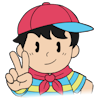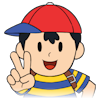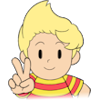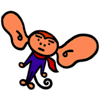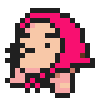MOTHER Series Creators
by: Echoes on 2/11/2020
The MOTHER series throughout its history has been a collaborative effort not only by the handful of companies involved, but also the people who left an impact during the creation of each game. None of these games would have been possible without their involvement!
Shigesato Itoi
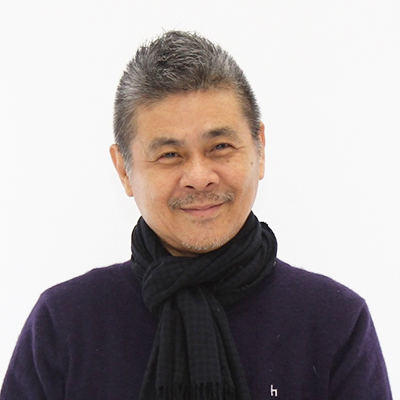
The renowned copywriter and creator of the MOTHER series, Shigesato Itoi, is a respectable celebrity in Japan, recognized for his nonchalant personality and quirky sense of humor. Besides MOTHER, Itoi has published short stories, essays, song lyrics, and even dabbled in the television industry through a guest appearance on Iron Chef, and starring in his own gold-mining show. When the video game boom happened in Japan during the mid-1980s, Itoi became invested in many games on his Famicom, most notably the Dragon Quest series, which inspired him to develop his own concept for a game. Itoi’s drive to stand out among the crowd led him to create something fresh and unique, two words often associated with the MOTHER series to this day.
Satoru Iwata

The late, great Satoru Iwata (d. July 11th, 2015) was the fourth president of Nintendo of Japan, but before he rose to that position, he was a humble employee at HAL Laboratories. He was a part-time programmer while attending university, eventually landing a full-time position there after graduating in 1982. While the development of MOTHER 2 was struggling in the early 90s, Iwata was recruited to the team to evaluate the situation and decided to reprogram the game from the ground up. Through his involvement, Iwata became not only one of Shigesato Itoi’s most trusted team members, but also one of his best friends. Satoru Iwata would remain involved in the subsequent development of MOTHER 64, though from a distance, as he was being inaugurated into Nintendo’s Board of Directors and Corporate Planning Division. Though he may no longer be with us, Satoru Iwata still lives as a precious memory in the minds of everyone involved with the MOTHER series, whether they are a developer or a player.
Shigeru Miyamoto
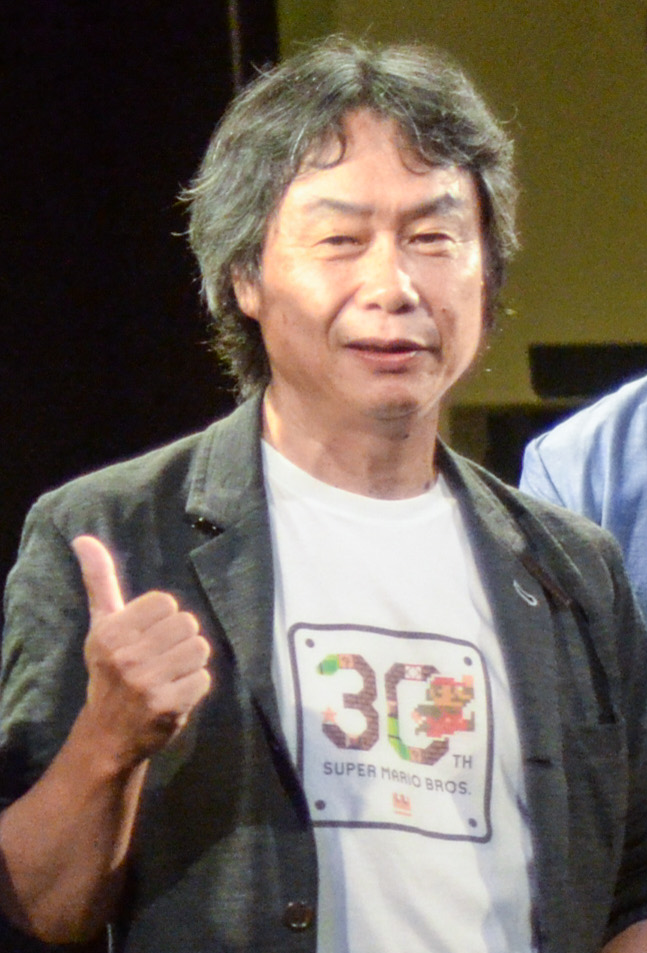
Believe it or not, the legendary “Willy Wonka” of the video game industry himself, Shigeru Miyamoto, has been involved with the MOTHER series since its inception. Miyamoto was hired at Nintendo in 1977 as an artist during the company’s first foray into the arcade industry. He approached game design from an unusually thoughtful perspective, prioritizing the creation of a story and characters before gameplay. This creative philosophy is something he shares in common with Shigesato Itoi, who had the same perspective when developing MOTHER. At first, Miyamoto was apprehensive of collaborating with a celebrity on a video game, especially one with such stature. Upon more thought and consideration, Miyamoto agreed to pursue Itoi’s pitch for the MOTHER series and helped him open up his own company, APE Inc. Shigeru Miyamoto would remain a supervisor on the project, keeping that position going into MOTHER 2 and MOTHER 64. His involvement in the MOTHER series stands as a testament to Miyamoto’s wide influence among not only Nintendo, but the industry as a whole. Just be sure to disregard his indifference to RPGs!
Hirokazu “Chip” Tanaka
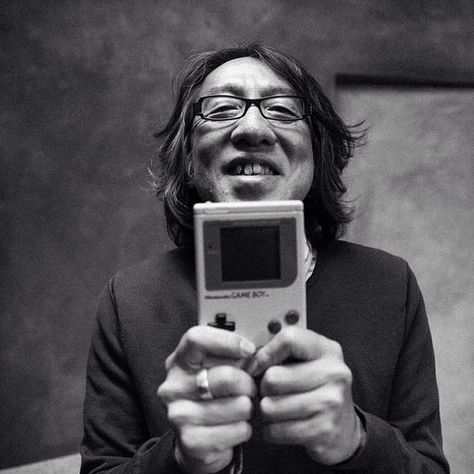
The current president of Creatures Inc. was the lead composer on the first two installments of the MOTHER series. He was the first sound engineer hired by Nintendo in 1980, composing soundtracks for their earliest arcade releases such as Radar Scope, plus the sound effects for the original Donkey Kong. “Hip” Tanaka programmed many of the sound chips used in these early arcade machines, eventually creating the sound chip for the Famicom and Game Boy. When working on the first MOTHER, Tanaka took the limitations of the hardware into consideration, finding it difficult to create the sounds he wanted to. This wasn’t an issue for MOTHER 2, as the new Super Famicom allowed composers to sample their own instruments, thus giving Tanaka more freedom to experiment. In 1998, Tanaka left Nintendo to pursue a job at Creatures Inc. composing for the Pokémon anime. He was eventually promoted to president of Creatures Inc. in 2001, remaining one of the most prolific and successful video game composers of all time.
Keiichi Suzuki
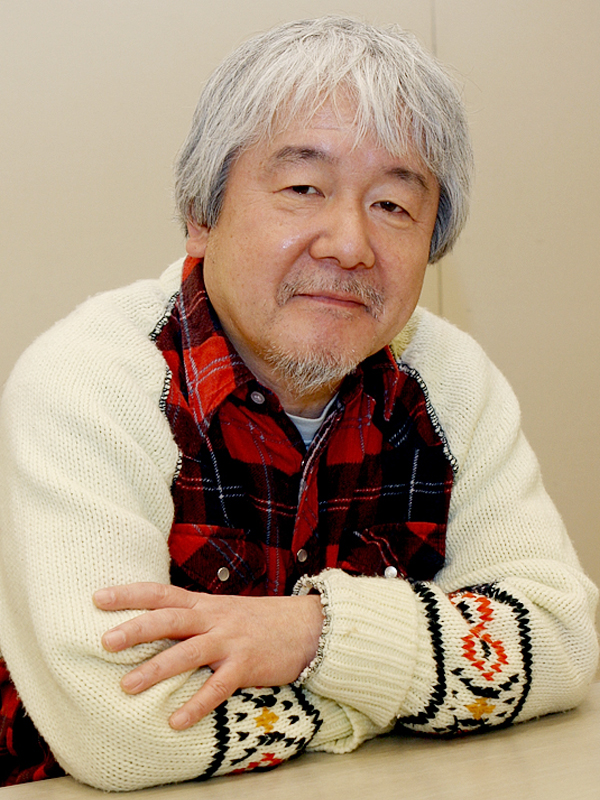
The soundtracks of the first two MOTHER games would not have been possible without the involvement of the musical genius Keiichi Suzuki. He began his career in the early 1970s, leading the classic rock movement in Japan through his involvement in bands such as Hachimitsu Pie and The Moonriders, the latter of which is still going strong today. Suzuki has dabbled his feet into just about every genre, from pop to the blues, which is what attracted the MOTHER team to reach out to him on the project in the first place. Many of the strange, yet iconic samples heard in MOTHER 2 were selected after long hours of discussion between Suzuki and Tanaka, cementing the beloved soundtrack as a collaborative effort. Following his tenure on the MOTHER series, Suzuki composed music for the game Real Sound: Kaze no Regret at Abbey Road Studios in London with guitarist David Gregory. In 2002 he opened his own record label company, Run, Rabbit, Run Records. Keiichi Suzuki has enjoyed great success over his long career, with MOTHER remaining one of his most celebrated works.
Nobuyuki Inoue

Unlike MOTHER or MOTHER 2, MOTHER 3 was not directed by Shigesato Itoi – it was directed by Brownie Brown writer Nobuyuki Inoue. In the 90s, he worked at Square as a scenario writer and game designer on games like Romancing SaGa, Hanjuku Hero, LIVE A LIVE, and Final Fantasy Tactics. In the 2000s, he began working at Brownie Brown as a director, scenario writer, and planner for Magical Vacation, MOTHER 3, and Fantasy Life, then became an independent writer in 2012, around when Brownie Brown split into Brownies and 1-UP Studio. His work has had a comeback in 2022 with two Nintendo Switch games that he worked on as a writer: Triangle Strategy and the remake of LIVE A LIVE.
Benimaru “Ashura” Itoh

Benimaru “Ashura” Itoh (Also known as the “Leopard Man”) is a freelance artist who was commissioned by Shigesato Itoi to develop character designs for the MOTHER series! He was born on Christmas Day in 1950, and has been drawing manga ever since he was in high school. He describes his art as “a blend of tastes from all over the world – of East and West, new and old, to hopefully make it my own.” Itoi took notice of his talents, and under his direction Itoh made the character designs for the original MOTHER (Which can be seen in strategy guides.) However, he was unable to commit to MOTHER 2 since he was making comics for several Nintendo publications at the time, and thus was replaced by Koichi Ooyama. Nevertheless, his support was seen in cameos of Ness, Paula and the Runaway Five in the Japanese Super Mario Kart guide book, as well as the official MOTHER 2 manga he drew! After finishing serialization on his Super Metroid comic in Nintendo Power, Itoh returned to APE to help production on MOTHER 64 as the art director in 1995. Together with Tsunekazu Ishihara, he reformed the company as it’s known today as Creatures Inc. He stayed at the company until 2002, directing the art on Pokémon Stadium and Pokémon Snap, in addition to the canceled MOTHER 64. Since then, Itoh has not only worked as a freelance artist for several game companies, but also has created designs for music albums and designer jackets! In his spare time, Itoh loves to collect vintage guitars and play music with his band “Poison Biscuits.” He hopes to dedicate more time to band activities in the near future!
Shogo Sakai

Neither Hirokazu Tanaka nor Keiichi Suzuki were available to commit themselves to the MOTHER 3 project, leaving humongous shoes to fill. Not only was Shigesato Itoi seeking somebody he could trust to continue the series’ signature sound in Tanaka and Suzuki’s absence, but also a person who understood the story on a personal level. Shogo Sakai, an up-and-coming video game composer from Data East, came as if out of nowhere to grant Itoi’s wish. He composed a demo disc of tracks which he presented to Miyamoto and Itoi, by which they were personally impressed, immediately hiring Sakai for the job. Every single aspect of the sound design in MOTHER 3 was crafted by Sakai himself, something that was nothing less than a monumental task. In fact, he was so deeply involved with the development of the game that he would often suggest what to do with the directions of certain scenes! Shigesato Itoi, when reflecting on the development of the game, regarded Sakai as “…a pillar of support. I really don’t think that MOTHER 3 could have been possible without him.” The music of MOTHER 3 immediately won the hearts of fans, placing Sakai on an equal pedestal with those who came before him!
Marcus Lindblom

The excellent localization of EarthBound would not have been possible without the involvement of one man: Marcus Lindblom. He began working for Nintendo of America at their call center while attending college. Soon after, he was promoted to a localizer due to his familiarity with the language after living in Japan for four years prior to his career at Nintendo. Localizing MOTHER 2 was nothing less than a daunting task due to the amount of text in the game, but with the aid of APE Inc. employee Masayuki Miura, Lindblom was able to create a fantastic English script for the game. Lindblom left Nintendo in 1996, hopping around various game studios ever since. In 2013 he opened his own mobile game studio: Carried Away Games. However, he still considers EarthBound his “greatest accomplishment”, staying involved in the community through many guest appearances with Fangamer.
Phil Sandhop

Phil Sandhop previously worked at Nintendo of America from 1987 to 2004. He was a product analyst who was involved with the localizations of Metroid II: Return of Samus, Super Mario 64, and most famously, EarthBound: Beginnings. Sandhop began work on the project after everything had been completed on the first Final Fantasy game, writing most of the English script himself. Testing was done by several Nintendo Gameplay Counselors, including Matt Alderman, but Sandhop himself contributed as well through the inclusion of the Run button which was only intended for debugging. Part of Sandhop’s job in rewriting the game into English was censoring anything that went against Nintendo’s policies, something he had to be very mindful of in pleasing both Nintendo of America and the original MOTHER team. Phil Sandhop was very impressed with the game and was disappointed it never had a release on the NES, describing MOTHER as “an empathetic story that makes you care about the characters”.
Miyuki Kure
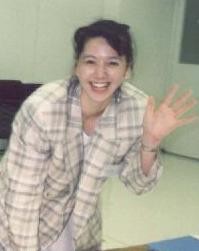
Miyuki Kure was Itoi’s personal assistant and a game designer for the original MOTHER for the Famicom. During her time at APE Inc, she helped Itoi rewrite all the temporary text into what you read in the final product! This was done by Kure sitting beside Itoi while on a computer, so they could review each line of text. Itoi would then vocalize what he’d like each line to say, word by word so Kure could type it into the computer for him! In retrospect, Itoi found Kure a little subdued, as she didn’t react much when he was vocalizing each line of dialogue, “…It was as if this girl felt she was in a weaker position, or believed her role was to say, “wow.” It still felt good for me to say it all, but when I got out of control, she couldn’t stop me.” When MOTHER was slated to come over to the West as “Earth Bound” in 1991, Kure directed the localization process with Phil Sandhop writing the English text. During the process, she reviewed everything to make sure Itoi’s spirit and intentions were kept in tact for the English version. Unfortunately, not much else is known about Kure, with her only other credits being Sorcerian in 1992 and Doraemon: Yume Dorobō to 7-nin no Gozans in 1993.
Toshinao Aoki

Toshinao Aoki is a freelance artist and animator, born in 1960. He has done art for numerous shows and movies, such as Keep Your Hands off Eizouken, Ugo Ugo Ruga, Dragon Pilot: Hisone and Masotan, and Your Voice -KIMIKOE-. He is married to fellow manga artist Fumiko Tanigawa, and contributed to the MOTHER series with enemy designs for MOTHER 64! Hoping to create a distinct contrast between human characters and enemies, Shigesato Itoi commissioned Aoki on the project after seeing his work on Ugo Ugo Ruga. Aoki would create enemies based around the locations Benimaru Itoh designed, drawing out a visual storyboard of how each enemy would move and attack! Although his art went unused in the Game Boy Advance version’s development, many shades of Aoki’s influence can be seen in the designs. Even in a more recent interview with Nintendo Dream from 2015, Itoi applauded Aoki’s work, stating it “matched the MOTHER” inside him best.
Akihiko Miura

Akihiko Miura was the lead game designer of MOTHER 2 and 64. He began his career at SEDIC Inc. in 1986, where he worked on games such as Tetris 2. He later joined APE Inc. in 1991, where he immediately joined the MOTHER 2 team as the lead game designer. In working on MOTHER 2, he felt there were many ideas the team had to scrap due to the Super Famicom hardware. So when it came time to work on MOTHER 64 on the N64 Disk Drive, Miura studied books on advanced mathematics and physics to help realize their ideas! Although MOTHER 64 never came out, Miura has continued working in the industry ever since. In 2012, he formed his own video game company “miuraani and associates”, creating titles such as Maiden Craft and Grand Summoners.
Masayuki Miura
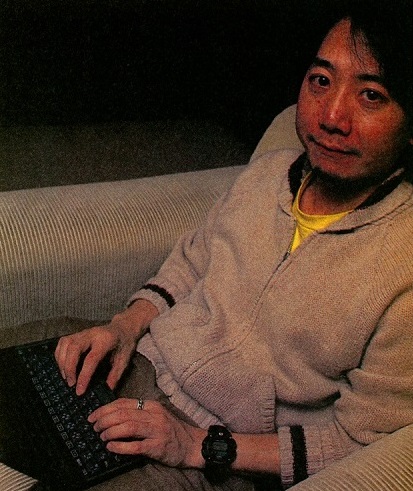
Masayuki Miura is Akihiko’s younger brother, who also worked on the MOTHER games at APE Inc! He replaced Miyuki Kure as Itoi’s assistant for MOTHER 2, and also helped with game design. As per tradition, in transcribing Itoi’s words, Miura would sit beside him with a laptop and type out every word he said, line by line. Miura would also act as a consultant during this process, critiquing Itoi’s ideas when necessary in hopes of making the writing as powerful as possible! After MOTHER 2 was completed, Miura directed the localization process for “EarthBound” just like Kure before him. This time around, he worked with Marcus Lindblom to make sure the English script was faithful to Itoi’s vision and strong in it’s own right. The two developed a strong bond, and are still friends to this day after reuniting on Twitter in August 2020! Since the MOTHER 2 team was carried over straight into MOTHER 64, Miura served the same role as Itoi’s assistant for that project. Much of the process was the same, with Miura hoping to include his favourite line of dialogue from the series, “Look me in the Eye!” (spoken by the guard dog outside Duncan’s Factory in MOTHER 1) into MOTHER 64. These days, Miura works at The Pokémon Company, credited as the game designer for Pokémon Duel and development producer for Pokémon Conquest.
Creatures (APE) Inc.

Creatures (formerly APE) Inc. is the company that led development on MOTHER, MOTHER 2, and MOTHER 64. It was founded by Shigesato Itoi under influence from Nintendo president Hiroshi Yamamuchi, in order to nurture the talent within young, aspiring game designers. Tsunekazu Ishihara was appointed as the first CEO of the company, from its inception as APE in March 1989 and through the restructure as Creatures in 1995. Ishihara was succeeded by MOTHER 1 and 2 composer Hirokazu Tanaka in 2001. The company’s focus following MOTHER has been co-developing the Pokémon games, including creating many of the cards and toys central to the success of the media franchise.
HAL Laboratory

Founded in 1980, HAL Laboratory has been responsible for the creation of the Kirby and Super Smash Bros. franchises. Originally, the company developed games for the MSX and Commodore line of systems, publishing a few Nintendo releases along the way, such as The Adventures of Lolo and Day Dreamin’ Davey. Following the threat of bankruptcy after a string of unsuccessful releases, Nintendo offered to save the company on the condition Satoru Iwata become president. This all occurred midway through the development of MOTHER 2, which HAL became involved in, hoping to salvage the failing project. HAL would continue on to co-develop MOTHER 64, mainly directing the art design of the game. Although MOTHER 64 was canceled, they provided the prototype as a reference for Brownie Brown when the torch was handed off to them developing MOTHER 3 for the Game Boy Advance. Without HAL coming in to save the day during MOTHER 2’s development, the series may have ended as only one title.
Brownies (Previously Brownie Brown)

Founded by ex-Square Enix employees in 2000 who left the studio due to “differing ideals”, Brownie Brown was the lead developer of MOTHER 3. In 2001, they developed their first game for the Game Boy Advance, Magical Vacation, followed by a remake of Seiken Densetsu: Final Fantasy Gaiden under the name “Sword of Mana”. Their success in creating RPGs for the hardware is likely what attracted Nintendo in approaching them to develop MOTHER 3, though their involvement with the project remained a secret for years. They were finally announced as the developers when a flash game under the name “Project B” launched on their site, resembling the iconic MOTHER style. Nintendo restructured their share of the company at the end of 2012 after Brownie Brown released Fantasy Life to become 1-Up Studio, leaving what was left to become Brownies. Brownies still keeps a MOTHER 3 poster filled with staff signatures in their office, including a signature from Masahiro Sakurai during the development of Super Smash Bros. Ultimate! Brownies currently creates games on modern platforms like Doraemon: Story of Seasons.
1-UP Studio (Previously Nintendo’s share of Brownie Brown)

After MOTHER 3, Brownie Brown would continue developing games for Nintendo’s handhelds. Nintendo restructured their share of Brownie Brown to become a subsidiary of Nintendo at the end of 2012 after they released Fantasy Life. Currently, 1-UP Studio has provided their assistance in developing the recent 3D Mario games, confirming them to be one of Nintendo’s most trusted partners!
Page Information & Contacts:
Writers and Editors
Echoes – Contextualized the written text and history of the base page. Contributed this page as of 2020.
8lackSphinx – Edited text.
Kody NOKOLO – Made additions about Brownies and Nobuyuki Inoue.
Find any errors or want to contribute? Let us know in our Discord!



